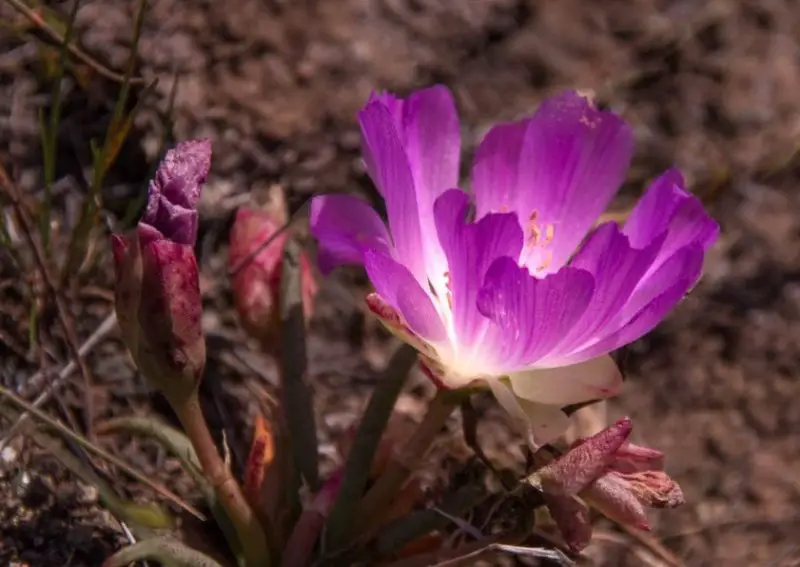Bitterroot (Lewisia rediviva) is a stunning perennial plant native to western North America. Known for its vibrant, cup-shaped flowers and ability to thrive in dry, rocky conditions, Bitterroot is a low-maintenance yet rewarding addition to any garden.
This guide will provide you with all the essential information on growing and caring for this unique plant.
Overview of Bitterroot (Lewisia rediviva)

Characteristics
- Botanical Name: Lewisia rediviva
- Common Names: Bitterroot
- Plant Type: Perennial
- Mature Size: 2-5 inches in height
- Flower Color: Pink, white, or magenta
- Bloom Time: Spring to early summer
- Sun Requirements: Full sun to partial shade
- Soil Type: Well-drained, sandy or rocky soil
- Hardiness Zones: USDA zones 3-9
- Growth Rate: Slow-growing, taking several years to fully establish
How to Grow Bitterroot (Lewisia rediviva)
Choosing the Right Location
Bitterroot (Lewisia rediviva) thrives in well-drained soil with plenty of sunlight, making site selection a crucial step in ensuring healthy growth. This plant naturally occurs in arid, mountainous regions where the soil is loose, rocky, and nutrient-poor. To recreate these conditions, it is important to find a location that provides adequate light, proper drainage, and minimal water retention.
Sunlight is one of the most essential factors for bitterroot. It requires at least six hours of direct sunlight per day to develop properly. A site with full sun exposure throughout the day is ideal, as too much shade can weaken the plant, slow its growth, and reduce flowering. If possible, planting on a south- or west-facing slope can help maximize sunlight exposure.
Soil quality is equally important. Bitterroot does not tolerate heavy, moisture-retentive soil, as excess water can lead to root rot and disease. The best conditions include sandy, gravelly, or rocky soil that drains quickly after rainfall. If the soil in your garden is naturally clay-heavy or compacted, amending it with coarse sand or small gravel can improve drainage. Raised beds or rock gardens are also excellent options for providing the dry, well-aerated environment that bitterroot needs to thrive.
Another important consideration is soil composition. Bitterroot prefers soil that is relatively low in organic matter. While many plants benefit from nutrient-rich soil, bitterroot does best in lean, infertile conditions where excessive nutrients do not encourage overly lush growth. The ideal soil pH falls between 6.0 and 7.5, meaning it should be neutral to slightly acidic.
Soil Requirements
Bitterroot (Lewisia rediviva) thrives in well-drained soil, making proper soil selection essential for its survival. In its natural habitat, this plant grows in rocky, sandy, or gravelly terrain, where water drains quickly and nutrients are relatively sparse. To successfully cultivate bitterroot, it is important to replicate these conditions as closely as possible.
The texture of the soil plays a significant role in preventing root rot, a common issue when plants sit in waterlogged conditions. Bitterroot prefers loose, well-aerated soil with a sandy or gravelly composition, which allows excess moisture to drain away rapidly. Heavy clay or compacted soils should be avoided, as they retain too much water and restrict root development. If necessary, amending the soil with coarse sand, small pebbles, or perlite can improve drainage and create a more suitable growing medium.
Soil pH is another crucial factor. Bitterroot thrives in a pH range between 6.0 and 7.5, meaning it prefers neutral to slightly acidic conditions. Soil that is too alkaline may inhibit nutrient absorption, while overly acidic soil can lead to poor growth. If the pH is outside the ideal range, adjustments can be made using soil amendments such as sulfur to lower alkalinity or lime to reduce acidity.
Unlike many other plants that benefit from nutrient-rich soil, bitterroot does best in low-fertility conditions. Excessive organic matter, such as compost or rich loam, can encourage excessive foliage growth at the expense of flowering. To maintain the right balance, it is best to avoid fertilizing the soil or adding high-nutrient amendments. Instead, a lean, mineral-rich substrate with minimal organic content will support healthy root development and encourage the plant to produce its characteristic vibrant blooms.
Planting Bitterroot
Bitterroot (Lewisia rediviva) can be grown from seeds or propagated through root cuttings, though seed propagation is the most common and effective method. Due to its unique growth cycle and adaptation to arid conditions, proper planting techniques are essential for successful establishment.
From Seeds
Growing bitterroot from seeds requires patience, as the seeds have a natural dormancy period that must be broken through cold stratification. This process mimics the natural winter conditions the seeds experience in the wild, ensuring proper germination.
The stratification process involves exposing the seeds to cold, moist conditions for 4 to 6 weeks. This can be done by placing the seeds in a damp paper towel inside a plastic bag and storing them in the refrigerator. Alternatively, nature can take care of this process by sowing the seeds directly outdoors in late fall, allowing winter temperatures to naturally prepare them for germination in the spring.
When sowing, scatter the seeds on the soil surface rather than burying them deeply. Bitterroot seeds require light to germinate, so a light dusting of fine sand or soil is sufficient to keep them in place. Ideal sowing times are late fall or early spring, ensuring they experience the necessary temperature fluctuations for successful sprouting.
After sowing, keep the soil slightly moist but not overly wet. Germination may take several weeks, depending on environmental conditions. Once seedlings emerge, gradually reduce watering to encourage deep root development. When spacing the plants, allow for 6 to 12 inches of space between them to ensure they have enough room to grow without competition.
From Cuttings or Divisions
Although seed propagation is the preferred method, bitterroot can also be propagated through root cuttings, though this approach is less common.
To propagate from cuttings, select healthy roots in early spring before the plant enters active growth. Carefully remove a section of the root system, ensuring that each cutting is a few inches long. Allow the cut ends to dry for a day before planting to reduce the risk of rot.
Plant the cuttings in well-draining sandy soil, ensuring they are positioned just below the surface. Water sparingly, as excessive moisture can lead to root decay. Once established, the cuttings will gradually develop into mature plants, though this method generally takes longer and has a lower success rate compared to seed propagation.
Caring for Bitterroot (Lewisia rediviva)
Watering Requirements
Bitterroot (Lewisia rediviva) is an exceptionally drought-tolerant plant that thrives in dry, rocky environments. Its natural habitat consists of well-draining, low-moisture soils, making it well-adapted to surviving with minimal water. Overwatering is one of the biggest threats to its health, as excessive moisture can cause root rot and fungal diseases.
During Establishment
Young bitterroot plants require occasional watering to help them develop a strong root system. During the first growing season, water lightly every two to three weeks, ensuring the soil is slightly moist but never saturated. If planted in a particularly hot or dry climate, occasional deep watering may be beneficial, but it is important to let the soil dry out between waterings.
Once Established
Mature bitterroot plants rarely require supplemental watering. Once the roots are fully developed, they can withstand extended dry periods, drawing moisture from the soil even in arid conditions. Watering is only necessary during prolonged droughts, especially if the plant shows signs of stress, such as wilting or shriveled leaves.
Avoid Overwatering
Since bitterroot is highly susceptible to root rot, maintaining proper soil drainage is crucial. Avoid watering too frequently or planting in areas where water tends to accumulate. If grown in a container or raised bed, ensure adequate drainage holes and use a sandy or gravelly soil mix to prevent water retention.
Light and Temperature Needs
Bitterroot (Lewisia rediviva) is well-adapted to a range of light and temperature conditions, making it a resilient plant for various climates. However, to ensure optimal growth and flowering, it is important to provide the right balance of sunlight, temperature, and seasonal care.
Light Requirements
Bitterroot thrives in full sun, requiring at least six hours of direct sunlight per day to encourage healthy growth and vibrant blooms. Ideally, it should be planted in an open, sunny location where it receives consistent light throughout the day. While it can tolerate partial shade, too much shade may reduce flowering and lead to leggy growth. In regions with extremely hot summers, providing some afternoon shade can help protect the plant from excessive heat stress.
Temperature Preferences
Bitterroot grows best in moderate temperatures ranging from 50°F to 80°F (10°C to 27°C). It is well-suited to temperate and arid climates, where seasonal temperature fluctuations are common.
Cold Tolerance
This hardy perennial can survive extremely cold temperatures, tolerating lows down to -30°F (-34°C). However, proper soil drainage is crucial for winter survival. In poorly drained soils, bitterroot may suffer from root rot during cold, wet conditions. To prevent this, planting in gravelly or sandy soil and avoiding excessive winter moisture will help maintain plant health.
Heat Resistance
Bitterroot is naturally adapted to dry, rocky environments and can tolerate high temperatures. In areas where summer temperatures frequently exceed 90°F (32°C), the plant may benefit from some afternoon shade, especially if grown in containers or exposed to direct sunlight for prolonged periods. Ensuring well-draining soil and reducing watering during hot spells will help prevent stress and maintain healthy growth.
Fertilization
Bitterroot (Lewisia rediviva) is naturally adapted to nutrient-poor soils and does not require heavy fertilization. In fact, excessive nutrients, particularly nitrogen, can be detrimental to its growth, leading to lush foliage at the expense of flowers.
For most growing conditions, bitterroot thrives without any added fertilizer. However, if the soil is extremely poor and lacks basic nutrients, a minimal amendment can be beneficial. In early spring, a light layer of compost or well-aged organic matter can be gently incorporated into the topsoil to provide a slight boost without overwhelming the plant. It is important to avoid rich, moisture-retentive composts, as bitterroot prefers lean, fast-draining soil.
Nitrogen-heavy fertilizers should be strictly avoided, as they encourage excessive leafy growth while reducing flower production. Instead, if supplementation is necessary, using a diluted, low-nitrogen, phosphorus-rich fertilizer can help support blooming. A balanced approach—favoring natural, minimal soil enrichment over heavy feeding—will keep bitterroot healthy and encourage its characteristic delicate blossoms.
Pruning and Maintenance
Bitterroot (Lewisia rediviva) is a low-maintenance plant that requires minimal intervention once established. However, occasional care can help promote healthy growth, prolong flowering, and protect the plant through seasonal changes.
Deadheading
Removing spent flowers can encourage prolonged blooming and prevent the plant from putting energy into seed production. While bitterroot typically flowers in late spring to early summer, deadheading faded blooms can sometimes stimulate a second, smaller flush of flowers. Gently snipping off the withered flowers at the base helps redirect energy toward root development and overall plant health.
Winter Care
Bitterroot naturally enters dormancy after flowering, with its leaves dying back by late summer. During this period, it requires little to no maintenance. In most climates, the plant is fully hardy and does not need additional protection. However, in regions with extremely cold winters, a light layer of mulch, such as fine gravel or dry leaves, can help insulate the roots and prevent frost heaving. It is crucial to avoid excessive moisture during winter, as wet soil can lead to root rot. Ensuring proper drainage is the best way to protect bitterroot during dormancy.
Weeding
Keeping the planting area free from aggressive weeds is essential for bitterroot’s growth. Because it thrives in nutrient-poor, well-drained soil, competition from invasive weeds can hinder its development. Regularly removing weeds around the plant ensures that bitterroot has sufficient space, light, and nutrients to grow undisturbed. Hand-pulling weeds is the preferred method, as bitterroot’s delicate roots can be disturbed by deep digging or heavy cultivation.
With minimal yet thoughtful care, bitterroot can thrive year after year, adding vibrant beauty to rock gardens, dry landscapes, and naturalized settings.
Common Pests and Diseases
Bitterroot (Lewisia rediviva) is a hardy and resilient plant with strong natural defenses against most pests and diseases. However, under certain conditions, it can be susceptible to a few common issues. Proper care, including well-draining soil and good air circulation, can significantly reduce the risk of problems.
Pests
Bitterroot is generally pest-resistant, but occasional infestations may occur, particularly in environments with high humidity or excessive moisture.
- Aphids – These tiny, sap-sucking insects can sometimes gather on new growth, weakening the plant and causing leaves to curl or yellow. While aphid infestations are rare, they can be controlled by rinsing the plant with water or applying insecticidal soap if necessary. Encouraging natural predators, such as ladybugs, can also help keep their population in check.
- Slugs and Snails – In damp conditions, slugs and snails may occasionally feed on tender young shoots, though mature bitterroot plants are rarely affected. To prevent damage, use physical barriers such as crushed eggshells or diatomaceous earth around the plants. Organic deterrents, such as copper tape or beer traps, can also be effective in controlling slug and snail populations.
Diseases
Bitterroot is most vulnerable to fungal diseases and root rot, both of which are typically caused by excessive moisture.
- Root Rot – This is the most serious threat to bitterroot, occurring when the plant sits in poorly drained, wet soil for extended periods. Signs of root rot include wilting, yellowing leaves, and a general decline in plant health. To prevent this, ensure that the plant is grown in sandy, gravelly, or well-draining soil, and avoid overwatering. If root rot is detected, affected plants should be removed to prevent the spread of the disease.
- Fungal Infections – In humid conditions, bitterroot may develop fungal issues, particularly if airflow is restricted. Symptoms can include discolored spots on leaves or stems. The best way to prevent fungal infections is to plant bitterroot in an area with good air circulation and to avoid overhead watering, which can leave moisture on the foliage and encourage fungal growth. If needed, a mild fungicidal treatment can help manage infections.
Companion Planting with Bitterroot
Bitterroot (Lewisia rediviva) thrives alongside other drought-tolerant plants that share its preference for well-drained, rocky, or sandy soils. When selecting companion plants, it is best to choose species that require similar growing conditions and do not compete for moisture.
- Sedum spp. (Stonecrop) – These low-growing succulents provide excellent ground cover while complementing bitterroot’s delicate flowers. Their fleshy leaves store moisture, allowing them to thrive in dry environments.
- Eriogonum spp. (Buckwheat) – A hardy native plant that produces small, clustered flowers, buckwheat attracts pollinators and adds texture to xeriscape gardens.
- Penstemon spp. (Beardtongue) – With tubular flowers that draw hummingbirds and bees, penstemon adds vertical interest to a drought-tolerant planting scheme.
- Sempervivum spp. (Hens and Chicks) – Another succulent well-suited for rocky landscapes, hens and chicks form attractive rosettes that contrast beautifully with bitterroot’s blooms.
Uses and Benefits of Bitterroot
Bitterroot is more than just an attractive ornamental plant; it has cultural, ecological, and practical significance.
- Ornamental Use – Bitterroot’s striking pink to magenta flowers make it a standout addition to rock gardens, alpine beds, and xeriscapes. Its ability to thrive in nutrient-poor soils makes it ideal for low-maintenance landscaping.
- Cultural Significance – Bitterroot holds deep importance in Native American traditions, particularly among the Salish and other Indigenous tribes. The plant’s edible roots were historically harvested, dried, and used as a vital food source.
- Wildlife Attraction – Bitterroot flowers provide nectar for pollinators, including bees and butterflies, contributing to healthy ecosystems. Planting bitterroot in a native garden helps support local wildlife while maintaining a sustainable, drought-resistant landscape.
Conclusion
Bitterroot (Lewisia rediviva) is a resilient and visually stunning perennial that thrives in dry, well-drained soils. With minimal care, it can provide beautiful blooms and enhance rock gardens and natural landscapes. By following these growing and care tips, you can enjoy the delicate beauty of this unique plant year after year.






